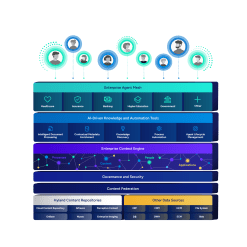Executive summary:
- Hyperautomation is an advanced method of automating business and IT processes across an organization, using a combination of tools like artificial intelligence (AI), robotic process automation (RPA), and business process management (BPM) to create more accurate and efficient workflows.
- Hyperautomation addresses the limitations of manual processes and outdated systems, enabling organizations to optimize operations, reduce costs, and improve efficiency.
- Challenges to hyperautomation can include existing legacy system capabilities and ensuring scalability.
Hyperautomation: Definition and why it matters
Definition: Hyperautomation is a streamlined approach to automating business and IT processes organization-wide for more accurate, accelerated workflows.
While automation involves the digitalization of a repetitive task without manual intervention, hyperautomation combines multiple automation tools and platforms to scale error-free efficiency. It includes the use of tools like artificial intelligence (AI), robotic process automation (RPA) and business process management (BPM).
Why it matters: Organizations should no longer be burdened by repetitive, manual processes and inefficient legacy infrastructure. All business operations can be optimized to deliver efficient results at reduced costs, so leaders can build a strong competitive edge in today’s data-driven environment.

Hyperautomation in today’s digital landscape
Hyperautomation is no longer an option for modern organizations.
Adopting a comprehensive and versatile automation strategy eliminates inefficient processing by integrating all automated processes across legacy systems so communication can flow seamlessly throughout the organization.
Government agency uses RPA to eliminate manual processing of 30,000 property tax returns
Auditor staff spent nearly six months each year processing more than 90,000 personal property tax returns. The manual effort tied up the workforce and limited other important tasks. Using Hyland RPA, Horry County automated tax return intake and used conditional business rules to tackle complexities. In year one, 30,000 returns were processed without human interaction, plus thousands more with limited oversight.
Read the case studyBenefits of hyperautomation
Streamlined operations: Optimizing business processes by eliminating repetitive tasks and automating manual ones to ensure consistency, accuracy and speed.
Enhanced customer experience: Reducing time-consuming manual tasks creates a digital workforce that empowers employees to focus on customer experience.
Integration: Integrating powerful analytical tools to accelerate processing creates an ecosystem of information workflow that helps employees work smarter.
Improved ROI: Delivering efficient outcomes and producing higher revenue and reduced costs with RPA and AI working together to scale operations.
Start the hyperautomation journey
- Identify workflow bottlenecks: Get insights on how existing operations and processes are executed. Identify gaps in efficiency and opportunities for digital process automation.
- Define outcomes: Prioritize the problems that can be solved. With quantifiable goals, organizations can accurately measure results and performance.
- Implement change management: Teams need full visibility on the benefits of investing in change. Encourage stakeholders to get involved by requesting suggestions and feedback.
- Evaluate workflow automation software: There are many variations of automation technology that might not serve an organization’s unique needs. Leverage strategic tools that can be scaled for expansion to other processes and departments. And consider factors like cloud operability, integration with existing systems and configuring workflows.

Watch the webinar: Navigating the Adoption of Intelligent Automation and AI
Curious about how intelligent automation and AI can transform your organization?
Hear from industry experts from Hyland and Deep Analysis as they cover key findings from the recent Deep Analysis: Market Momentum Index report. Learn the current trends, actionable strategies and best practices to overcome challenges like data quality and process optimization.
Hyperautomation and Hyland
Leveraging automation tools is a critical step to addressing new business challenges and digital transformation strategies. With Hyland’s content solution platforms, organizations can access a range of automation tools that drive agility and speed to market:
Artificial intelligence (AI): Hyland’s AI-powered technology, including intelligent capture and intelligent document processing, leverages machine learning to recognize, extract and validate key data to speed up the decision-making process and eliminate the need for manual data entry.
Robotic process automation (RPA): With Hyland RPA, organizations enable a digital workforce, improve the user experience and accelerate digital processes with full visibility.
Business process management (BPM): Automated workflows and dynamic business activity monitoring are just a few of the process management tools that help organizations hit the ground running on the hyperautomation journey.
Hyland’s host of automated tools can support hyperautomation efforts, from stand-alone solutions like Hyland RPA and Hyland IDP, to Hyland Automate, our newest platform that leverages AI and advanced capabilities to help organizations intelligently automate content-centric processes.
Frequently asked questions
How can an organization begin implementing hyperautomation, and what are the initial steps?
Begin by assessing current processes to identify automation opportunities. Map out workflows, identify inefficiencies and prioritize tasks for automation. Select the right combination of AI, RPA and BPM tools that align with strategic goals. Hyland’s platforms offer the support and expertise needed for a smooth transition.
How scalable are the hyperautomation solutions provided by Hyland?
Hyland's solutions are highly scalable, fitting any organization size or industry. Small businesses to large enterprises can tailor automation across various departments. Start small and expand incrementally to adapt to changing demands efficiently.
What are the challenges for integrating hyperautomation tools with existing legacy systems?
Integrating hyperautomation with legacy systems faces significant challenges. Compatibility issues may arise because outdated technology often doesn't support modern automation tools.
Data silos can occur as old systems store information in isolated formats. These obstacles arise from a lack of standardization and the piecemeal evolution of IT infrastructure over time.
Overcoming these challenges requires an assessment of the IT landscape and identifying specific integration points. Using APIs or middleware can bridge gaps, facilitating smooth data flow. Hyland’s tools offer high customization to meet specific industry requirements.
What are the tech requirements for hyperautomation?
Hyperautomation requires a robust infrastructure with a reliable network, adequate server capacity and up-to-date software. Hyland’s platforms are compatible with a wide range of systems, leveraging existing technology investments. Cloud and hybrid deployment options provide flexibility for diverse infrastructure needs.
You might also like:

Article
Intelligent automation 101
Here's how intelligent automation minimizes the manual "legwork" and ramps up your team's ability to focus on high-level strategy.

Article
The ultimate guide to enterprise automation
Learn more about the forms of enterprise automation — your organization’s ticket to greater efficiency, productivity and precision.

Article
Artificial intelligence (AI) and data capture: An evolution of efficiency
From Siri and Alexa to customer service chatbots, artificial intelligence (AI) has fundamentally changed many aspects of the way we work — and data capture is no exception.











